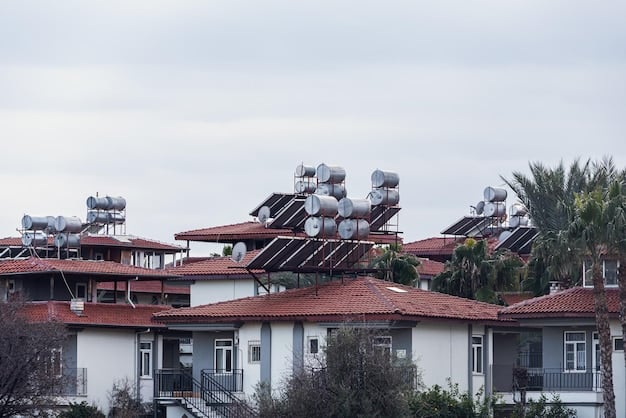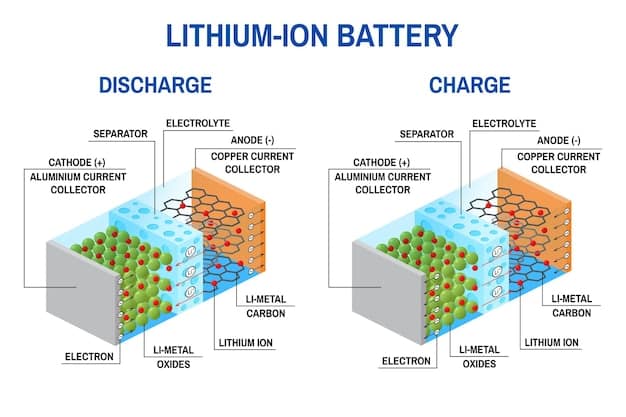Solar Panel Efficiency: Maximizing Your Power in 2025

Solar panel efficiency is crucial for maximizing energy production; in 2025, advancements in technologies like perovskite and heterojunction cells promise significant improvements in power output compared to traditional silicon panels, offering homeowners and businesses more sustainable energy solutions.
Investing in solar panels is a significant decision, and understanding solar panel efficiency: Which technology will give you the most power in 2025? is paramount. As technology advances, different types of solar panels offer varying levels of efficiency. This guide will help you navigate the options and choose the best technology for your energy needs.
Understanding Solar Panel Efficiency
Understanding solar panel efficiency is paramount when considering a solar energy investment. It directly impacts how much electricity you can generate from your available space.
Efficiency ratings reflect a panel’s ability to convert sunlight into usable electricity. Let’s delve into the key factors that influence this crucial metric.
What is Solar Panel Efficiency?
Solar panel efficiency is the percentage of sunlight that a solar panel can convert into electricity. A higher efficiency rating means the panel can produce more electricity from the same amount of sunlight.
This is particularly important for those with limited roof space or high energy demands.
Factors Affecting Solar Panel Efficiency
Several factors can affect a solar panel’s efficiency, including:
- Panel Technology: Different solar cell technologies (e.g., monocrystalline, polycrystalline, thin-film) have inherent efficiency differences.
- Temperature: Solar panels perform best in moderate temperatures. High temperatures can reduce efficiency.
- Shading: Partial or complete shading can significantly decrease a panel’s output.
- Angle and Orientation: The angle at which sunlight hits the panel and the orientation of the panel towards the sun impact energy production.
Understanding these factors will help you optimize your solar panel system for maximum efficiency.
In conclusion, solar panel efficiency is a critical factor to consider, influenced by technology, environmental conditions, and installation practices. Optimizing these aspects ensures the best possible energy production from your solar investment.

Current Solar Panel Technologies and Their Efficiency
The landscape of solar panel technology is constantly evolving. Several types of solar panels are currently available, each with its own efficiency profile.
Selecting the right technology is crucial for optimizing your energy production and return on investment.
Monocrystalline Solar Panels
Monocrystalline solar panels are made from a single crystal of silicon, making them highly efficient. They are easily recognizable by their uniform dark black appearance.
These panels are known for their long lifespan and high performance in various weather conditions.
Polycrystalline Solar Panels
Polycrystalline solar panels are made from multiple silicon crystals. They have a slightly lower efficiency compared to monocrystalline panels and a distinctive blue, speckled appearance.
They tend to be more affordable, making them a popular choice for budget-conscious consumers.
Thin-Film Solar Panels
Thin-film solar panels are made by depositing thin layers of photovoltaic material onto a substrate. They are flexible and lightweight but generally less efficient than crystalline panels.
They are often used in large-scale solar farms or integrated into building materials.
- Monocrystalline: Highest efficiency, sleek appearance, durable.
- Polycrystalline: More affordable, slightly lower efficiency, good overall performance.
- Thin-Film: Flexible, lightweight, lower efficiency, suitable for large-scale applications.
Choosing the right technology depends on your specific needs, budget, and available space.
In conclusion, each solar panel technology offers unique advantages and disadvantages. Monocrystalline panels lead in efficiency, while polycrystalline provide a cost-effective alternative. Thin-film panels offer flexibility for specialized applications. Considering these factors is key to making an informed decision.
Emerging Solar Panel Technologies for 2025
Looking ahead to 2025, several emerging technologies promise to revolutionize solar panel efficiency. These innovations have the potential to significantly increase power output and lower costs.
Keep an eye on these advancements as they could become mainstream options in the near future.
Perovskite Solar Cells
Perovskite solar cells are made from a calcium titanium oxide mineral structure and are known for their high efficiency and low manufacturing costs. They have shown rapid improvements in efficiency in recent years.
However, they are still under development and face challenges related to long-term stability.
Heterojunction Solar Cells
Heterojunction solar cells combine different types of silicon to maximize sunlight absorption and conversion. They offer higher efficiency than traditional silicon panels and perform well in high temperatures.
These panels are gaining popularity due to their superior performance and reliability.
Quantum Dot Solar Cells
Quantum dot solar cells use tiny semiconductor nanoparticles to absorb sunlight. They have the potential to achieve very high efficiencies by tuning the size of the quantum dots to absorb different wavelengths of light.
This technology is still in the early stages of development but shows great promise.

In conclusion, emerging solar panel technologies like perovskite, heterojunction, and quantum dot cells are poised to transform the solar energy landscape. These innovations promise higher efficiencies and lower costs, making solar power more accessible and sustainable for the future.
Factors to Consider When Choosing Solar Panel Technology
Selecting the right solar panel technology involves considering various factors beyond just efficiency ratings. These factors affect the overall performance, cost-effectiveness, and suitability of your solar panel system.
Evaluate these aspects to make an informed decision that aligns with your specific needs.
Cost vs. Efficiency
While higher efficiency panels can generate more power, they often come with a higher price tag. It’s essential to balance the initial cost with the long-term energy savings.
Consider your budget and the payback period to determine the most cost-effective option.
Space Availability
If you have limited roof space, higher efficiency panels can help you maximize energy production in a smaller area. This is particularly important for urban homeowners.
Lower efficiency panels might be suitable if you have ample space.
Climate Conditions
Some solar panel technologies perform better in certain climates. For example, heterojunction panels excel in high-temperature environments, while others may be more susceptible to performance degradation.
Research how different panels perform in your local climate.
- Cost: Balance initial investment with long-term energy savings.
- Space: Maximize energy production in limited areas with high-efficiency panels.
- Climate: Choose panels that perform well in your local weather conditions.
Weighing these factors will guide you towards selecting the optimal solar panel technology for your needs.
In conclusion, choosing solar panel technology requires a comprehensive evaluation of cost, space availability, climate conditions, and energy needs. Prioritizing these factors ensures a well-informed decision that maximizes the value and performance of your solar investment.
Installation and Maintenance for Optimal Efficiency
Proper installation and ongoing maintenance are critical for ensuring optimal solar panel efficiency. These practices help maintain performance and extend the lifespan of your solar panel system.
Follow these guidelines to keep your solar panels operating at their best.
Professional Installation
Hiring experienced professionals for installation is crucial. They can ensure the panels are properly oriented, angled, and connected for maximum sunlight capture.
A poor installation can significantly reduce efficiency and void warranties.
Regular Cleaning
Dust, dirt, and debris can accumulate on solar panels, reducing their ability to absorb sunlight. Regular cleaning is necessary to maintain optimal performance.
Use a soft brush and mild soap to gently clean the panels.
Monitoring System Performance
Monitoring your solar panel system’s performance allows you to identify potential issues early on. Many systems come with monitoring software that tracks energy production and alerts you to any anomalies.
Address any problems promptly to prevent further efficiency loss.
In conclusion, proper installation, regular cleaning, and diligent monitoring are essential for maximizing solar panel efficiency and ensuring the long-term performance of your solar energy system.
Future Trends in Solar Panel Efficiency
The future of solar panel efficiency is bright, with ongoing research and development pushing the boundaries of what’s possible. Several trends are shaping the next generation of solar technology.
Staying informed about these trends will help you anticipate future advancements and make strategic decisions about your solar energy investments.
Increased Efficiency Ratings
Researchers are continually working to improve the efficiency ratings of solar panels. New materials and designs are expected to push efficiencies beyond 30% in the coming years.
This will lead to more power generation from smaller areas and lower costs per watt.
Integration with Energy Storage
Combining solar panels with energy storage solutions, such as batteries, is becoming increasingly common. This allows homeowners to store excess energy generated during the day and use it at night or during periods of low sunlight.
This combination enhances energy independence and grid stability.
Smart Solar Panels
Smart solar panels incorporate advanced technologies, such as microinverters and optimizers, to maximize energy production. These components optimize the performance of each panel individually, mitigating the impact of shading or other issues.
Smart panels enhance overall system efficiency and reliability.
| Key Point | Brief Description |
|---|---|
| 💡 Efficiency Matters | High efficiency means more power from sunlight. |
| ☀️ Panel Types | Monocrystalline, Polycrystalline, and Thin-Film have different efficiencies. |
| 🚀 Emerging Tech | Perovskite and Heterojunction cells offer potential gains. |
| 💰 Cost Factors | Balance cost with efficiency for best value. |
Frequently Asked Questions
▼
Monocrystalline solar panels are generally the most efficient, converting a higher percentage of sunlight into electricity compared to other technologies like polycrystalline or thin-film.
▼
High temperatures can reduce solar panel efficiency. As panels heat up, their voltage decreases, leading to lower power output. Some technologies, like heterojunction, handle heat better.
▼
Perovskite solar cells are a new type of solar cell made from a calcium titanium oxide mineral structure. They are promising because of their potential for high efficiency and low manufacturing costs.
▼
The frequency of cleaning depends on your environment. In dusty or polluted areas, cleaning every 6 months is recommended. In cleaner environments, annual cleaning may suffice.
▼
Professional installation ensures proper panel orientation, angle, and secure connections, maximizing sunlight capture. Poor installation can significantly reduce efficiency and potentially void warranties.
Conclusion
As we look to 2025, understanding the nuances of solar panel efficiency is essential for making informed decisions about renewable energy investments. By considering the various technologies, factors affecting performance, and future trends, you can choose the solar panel system that best meets your needs and helps you maximize your power output. The continued advancements in this field promise a brighter, more sustainable energy future for all.





